 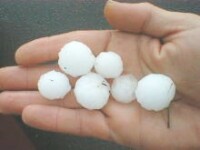 Large thunderstorms are often accompanied by hail. Hail forms when strong currents of rising air, known as updrafts, carry rain droplets above the freezing level in thunderstorms and the water freezes into ice.
Large thunderstorms are often accompanied by hail. Hail forms when strong currents of rising air, known as updrafts, carry rain droplets above the freezing level in thunderstorms and the water freezes into ice.Hail sometimes melts before it reaches the ground, but often it falls to the ground as ice chunks, which can be as small as grains of rice, or as large as softballs. Large hailstones can do severe damage to vehicles and crops. 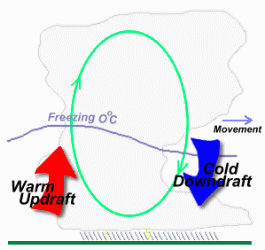
Storm clouds, called cumulonimbus clouds, contain a lot of energy in the form of winds, which move upwards (updrafts) and downwards (downdrafts). These winds can reach speeds over 170 km/h. Hail grows when water droplets are carried upwards, where temperatures fall to below freezing. The water droplets become 'supercooled', remaining in liquid form even though the surrounding temperature is below 0°C. But the cloud also contains ice crystals and dust particles; as the supercooled water droplets collide with these particles, they freeze. Eventually the particles become covered with a layer of ice. These ice pellets are then carried downwards by a downdraft, where they may fall to the ground as small hail. However, sometimes they are carried back up into the cloud, where they again receive a new layer of ice. This cycle can be repeated over and over, causing the ice pellets to grow very large. Eventually these large ice balls will be too heavy to be supported by the updraft winds, and they will fall to the ground as large hail stones. 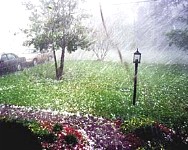 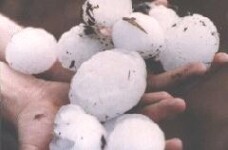 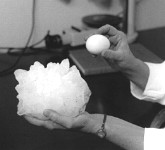 Hailstones can be tiny pellets, or large stones, which sometimes are quite irregular in shape. 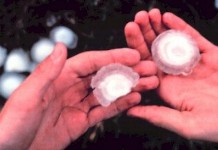 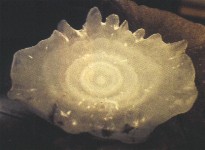 Hailstones that are split apart often show layers, like an onion. The layers are caused by the different rates of accumulation and freezing of the supercooled water, as the hailstone is repeatedly sent back upwards into the cloud. Some layers are thicker than others, because some parts of the cloud have more supercooled water than others. Hailstones that are split apart often show layers, like an onion. The layers are caused by the different rates of accumulation and freezing of the supercooled water, as the hailstone is repeatedly sent back upwards into the cloud. Some layers are thicker than others, because some parts of the cloud have more supercooled water than others. The more supercooled water that freezes onto the hailstone, the larger and heavier the stone will become. When the hailstone becomes so heavy that the updraft can no longer support it, it falls to the ground. 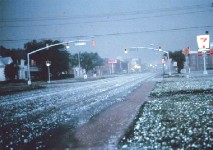 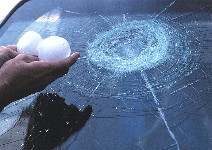 Hail falls along paths that can vary in size from a few square acres to hundreds of square kilometers. After a hailstorm, hail can be so thick on the ground that it has to be removed with a snow plow. Hailstorms can cause millions of dollars in property damage, mostly to automobiles, windows, and roofs. Hail falls along paths that can vary in size from a few square acres to hundreds of square kilometers. After a hailstorm, hail can be so thick on the ground that it has to be removed with a snow plow. Hailstorms can cause millions of dollars in property damage, mostly to automobiles, windows, and roofs.
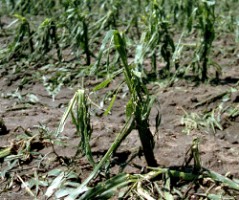 Hail also does a great deal of damage to crops, often as much as hundreds of millions dollars in the U.S. and Canada each year. Even small hailstones can destroy crops, slicing plants to pieces in just a few minutes. Hail also does a great deal of damage to crops, often as much as hundreds of millions dollars in the U.S. and Canada each year. Even small hailstones can destroy crops, slicing plants to pieces in just a few minutes. In the past, farmers were wiped out when their crops were destroyed. Today, however, farmers can purchase hail insurance. But it's expensive; hail insurance costs farmers billions of dollars yearly in the U.S. and Canada. In previous centuries, people attempted to stop hail from falling by ringing church bells and firing cannons. Hail cannons were commonly used in the wine-producing regions of Europe, and modern versions are still used in parts of Italy. Scientists are still experimenting with cloud "seeding" as a way of reducing hail size. Silver iodide crystals are fired into thunderclouds from the ground, stimulating the formation of small hailstones, which melt before they reach the ground. In addition, hail storms can be seen on radar, allowing as much as 15 minutes warning before the storm strikes. While this may not protect crops, it is enough warning to prevent some property damage. |